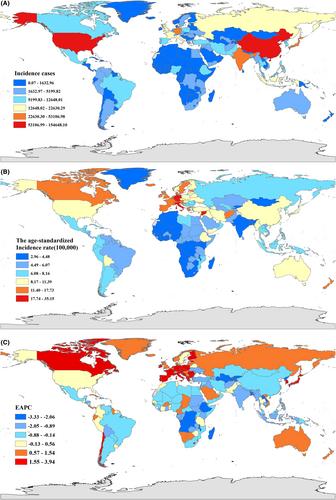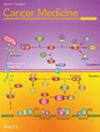Global, regional, and national burdens of leukemia from 1990 to 2019: A systematic analysis of the global burden of disease in 2019 based on the APC model
Abstract
Background
Leukemia is the tenth most common cause of cancer death worldwide and one of the most important causes of disability. To understand the current status and changing trends of the disease burden of leukemia at the global, regional, and national levels, and to provide a scientific basis for the development of leukemia prevention and treatment strategies.
Methods
Based on open data from the Global Burden of Disease Study 2019 (GBD 2019), R software was used to calculate estimated annual percentage changes to estimate trends in the age-standardized incidence (ASIR) and the age-standardized disability-adjusted life years (DALY) rate due to leukemia and its major subtypes from 1990 to 2019.
Results
In 2019, globally, the number of incidences and DALYs of leukemia were 643.6 × 103 (587.0 × 103, 699.7 × 103) and 11,657.5 × 103 (10529.1 × 103, 12700.7 × 103), respectively. The ASIR (estimated annual percentage change (EAPC) = −0.37, 95%UI −0.46 to −0.28) and the age-standardized DALY rate (EAPC = −1.72, 95%UI −1.80 to −1.65) of leukemia showed a decreasing trend from 1990 to 2019. The APC model analysis showed that the age effect of leukemia risk was a “U”-shaped distribution of relative risk (RR) with increasing age from 1990 to 2019, globally. The time effect was an increase in incidence rate with increasing years but a decrease in DALY rate with increasing years. The cohort effects of both incidence and DALY rates tended to increase and then decrease with the development of the birth cohort. In 1990 and 2019, smoking, high body-mass index, occupational exposure to benzene, and occupational exposure to formaldehyde were risk factors for DALY in leukemia, especially in areas with high SDI.
Conclusions
From 1990 to 2019, the disease burden of leukemia showed a decreasing trend, but it is worth noting that its overall severity is still very high. The disease burden of leukemia varies greatly from region to region, and exclusive strategies for the prevention and treatment of leukemia should be developed according to the economic and cultural development of each region.


 求助内容:
求助内容: 应助结果提醒方式:
应助结果提醒方式:


